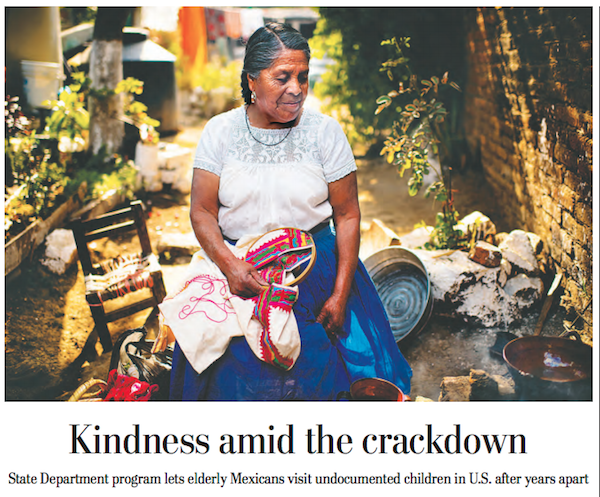Is the immigration sob story genre making a comeback? As I pointed out in my 2002 article, The Style Guide To Writing A Sensitive Immigrant Story, emotions are foremost, showing the humanity of foreigners who are illegally present in this country, because liberal ideology is not interested in such details.
The New York Times featured a front-page illegal alien tear-jerker on Memorial Day that was filled with migrant family travails as they rode the Greyhound to their new home in stupid-generous America.
On Tuesday, the Washington Post responded with another kind of family story, where Mexican grandparents visited offspring stuck in America by their unlawful immigration status. (Wait, isn’t Mexico prosperous these days with its #15 GDP ranking?)
The State Department set up the travel deal, revealing itself as one of the many anti-Trump, anti-sovereignty centers in Washington.
The Post’s front-page story featured a colorful photo of a Mexican granny, emphasizing diverse family values:

The Post story was reprinted in Stripes.com (a US military website, hmm) so click freely if you are not a paid-up Post subscriber:
Elderly Mexicans visiting their undocumented children in US with State Department approval, Washington Post, May 25, 2019
CHERAN, Mexico — María Dominga Romero León bent over a small black suitcase and packed her things, one by one: a folder of photographs, a half-finished blouse, a bag of wooden toys for the grandchildren she’d never met.
She sighed.
“They’re probably used to America by now,” she said.
Romero León, 68, hadn’t seen her daughter Guillermina in so long that she was starting to lose track of the years. Had it been 15 or 20? She wasn’t sure. What she knew was that Guillermina was an undocumented immigrant in a place called Germantown in Illinois with three children of her own. Two were U.S. citizens; one was a beneficiary of the federal program Deferred Action for Childhood Arrivals.
Romero León knew that U.S. immigration laws made it impossible for her daughter to come back to Cheran without jeopardizing the life she had built in the United States, because she didn’t have papers to move back and forth across the border.
That’s why Romero León was packing her bags. She had never been on an airplane, or been to an airport, or seen an escalator – she’d never left her home state of Michoacan. But now she was getting ready to fly to America.
The U.S. government – the same government from which Romero León’s daughter was hiding – had surprised her with a tourist visa.
Officials in Michoacan call them Palomas Mensajeras (Messenger Pigeons.) They are parents and grandparents in Mexico who have not seen their undocumented children in the United States for years, even decades.
Since 2017, officials here have been working with the U.S. State Department to reunite those families for three-week visits in cities and towns across the United States.
For many here, it is an unlikely American olive branch amid the Trump administration’s crackdown on illegal immigration. But it has been welcomed by immigrant families grappling with a crisis that has rippled across both countries: The elderly parents of the estimated 5 million undocumented Mexicans in the United States are dying alone in Mexico while their children remain stuck on the other side of the border.
Romero León’s husband died of complications from diabetes a year ago. During his final days, she held a phone to his ear so their children could speak to him from the United States. Three of the couple’s six children were undocumented immigrants living across the border.
“It was hard for him,” Romero León said, “to be sick, to be dying so far away from them.
“I thought, ‘Will it be the same for me?’ ”
Still, when she learned that she would be joining 21 other elderly residents from around Cheran on a flight to Chicago, she found it hard to understand. Why had the United States granted her a visa? Was it a trick to apprehend her daughter?
“That’s what I’m worried about,” she said. “Are they going to use this to arrest them?”
___
The U.S. government hasn’t specifically endorsed the program, a State Department spokesman said in a statement. But officials last year began designating special interview days at the U.S. Embassy in Mexico City for elderly visa applicants who “frequently travel in groups to the United States for a variety of reasons including tourism, cultural programs, and to visit friends and family such as U.S. citizen grandchildren.”
The spokesman made no mention of the generation between the Mexican grandparents and the American grandchildren. But in practice, the Palomas Mensajeras program is exclusively for elderly Michoacanos who live in Mexico and have undocumented children in the United States.
Trump – of the border wall proposal, family separations and the national emergency at the U.S.-Mexico border – has taken a different approach toward the undocumented. “Please do not make yourselves too comfortable,” he tweeted this month, “you will be leaving soon!”
The State Department spokesman declined to answer questions about why the United States is facilitating reunions between Mexicans and their undocumented children. (Continues)


